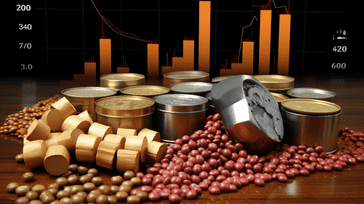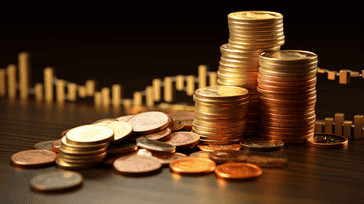Commodity Prices: The Relationship with Economic Indicators

Commodity prices and economic indicators share an intrinsic connection. The health of an economy is often reflected in the prices of commodities, such as oil, gold, and copper, among others.
Economic indicators are statistical data points that provide insights into the health of an economy. They help analysts and investors understand how the economy is performing and predict future trends. Examples of economic indicators include Gross Domestic Product (GDP), inflation, and employment numbers.
As commodity prices are dependent on supply and demand, changes in economic indicators can impact their prices. For instance, a rise in GDP can lead to an increase in demand for commodities, which can push their prices higher. Conversely, a decline in employment numbers could reduce demand for commodities, causing their prices to drop.
In this article, we'll explore the relationship between commodity prices and economic indicators. We'll discuss the various types of economic indicators and their significance in analyzing market trends and financial forecasts. We'll also delve into the impact of global economic indicators on commodity markets.
Key Takeaways:
- Economic indicators play a crucial role in understanding the performance of an economy.
- Commodity prices are influenced by changes in economic indicators.
- The connection between economic indicators and commodity prices is important for financial analysis and decision-making.
- Global economic indicators have a significant impact on commodity markets.
- Understanding economic indicators can help predict market movements and make informed investment decisions.
Understanding Economic Indicators
Economic data is a critical element in analyzing the health and performance of any economy. Economic indicators are statistical metrics that gauge the changes and trends in economic activities, and they provide insights into how the economy is faring and what the future holds.
Defining economic indicators involves categorizing them into three types: leading, lagging, and coincident. Leading indicators provide a glimpse into the future direction of the economy, while lagging ones confirm past trends. Coincident indicators occur simultaneously with economic activity and help analysts measure the current state of the economy.
The collection and analysis of economic data often involve various government agencies and private organizations, such as the Bureau of Labor Statistics and the Conference Board. Economic indicators encompass a broad spectrum of data, including employment rates, inflation, consumer spending, and housing starts, among others.
Types of Economic Indicators
Each type of economic indicator provides insights into different aspects of economic activity. Leading indicators are those that help predict the direction of the economy. Some examples of leading indicators are:
| Leading Indicators | Description |
|---|---|
| Stock Market Index | Stock market performance indicates investor sentiment and corporate earnings prospects. |
| Building Permits | The number of building permits issued reflects future construction activity, a vital component of the economy. |
Lagging indicators, on the other hand, confirm past trends and performance. Examples of lagging indicators are:
| Lagging Indicators | Description |
|---|---|
| Unemployment Rate | Unemployment rate is a lagging indicator that confirms past economic activity. |
| Consumer Price Index (CPI) | CPI measures inflation and reflects past changes in pricing levels, a key aspect of economic performance. |
Understanding economic indicators' definitions and types is an essential step in analyzing any economy's performance and health. Accurate and timely data collection and analysis are crucial in gauging how the economy is faring and what the future holds.
Leading Economic Indicators

Leading economic indicators are statistical tools used to forecast future economic trends. They provide crucial insights into where the economy is heading by analyzing key data points. The following are examples of leading economic indicators:
| Indicator | Description |
|---|---|
| Stock Market | Indices, such as the S&P 500, that measure the overall performance of the stock market. A rise or fall in the stock market can signal changes in investor sentiment and overall economic activity. |
| Consumer Confidence | A survey that measures how confident consumers are about the economy. A rise in consumer confidence indicates people are more likely to spend, stimulating economic activity. |
| Building Permits | The number of permits issued for residential construction. A rise in building permits signals an increase in construction activity, which often translates to job growth and increased spending. |
| Manufacturing Orders | The volume of orders received by manufacturers. A rise in manufacturing orders indicates increased demand for goods, signaling economic growth and job creation. |
The Significance of Leading Economic Indicators
Leading economic indicators are significant because they provide early warnings of potential changes in the economy. By identifying trends in key data points, analysts can make informed predictions about future economic activity and adjust their strategies accordingly.
For example, if consumer confidence is falling, it may signal a decrease in consumer spending, which could lead to slower economic growth. By analyzing leading indicators, businesses and investors can adjust their plans to account for potential shifts in the economy.
Overall, understanding leading economic indicators is crucial for anyone looking to make informed decisions about the economy and financial markets.
Lagging Economic Indicators: Understanding Their Significance and Examples
While leading economic indicators provide insights on future economic trends, lagging economic indicators offer retrospective information on past economic performance. As the name suggests, lagging indicators tend to follow changes in economic activity and are therefore viewed as confirmatory indicators rather than predictive.
Examples of lagging economic indicators include:
| Economic Indicator | Definition |
|---|---|
| Unemployment rate | The percentage of the labor force that is unemployed and actively seeking employment. |
| Corporate profits | The after-tax profits of all corporations in the economy. |
| Inflation | The rate at which the general level of prices for goods and services is rising over time. |
| Consumer debt | The amount of outstanding debt held by consumers, including credit card debt, auto loans, and mortgages. |
These lagging indicators are essential for validating or disproving economic trends identified by leading indicators. They are also used to determine if an economic recovery is underway and whether it is sustainable.
For example, if leading indicators suggest an economic recovery is imminent, economists will analyze lagging indicators like employment rates to determine if the recovery is indeed occurring. If employment rates show an increase, it is a positive sign that the recovery is happening.
In summary, while leading indicators provide a glimpse of what's on the horizon, lagging indicators offer a retrospective view of economic trends. Both types of indicators are important for analyzing the economy and making informed financial decisions.
Global Economic Indicators: Understanding the Major Indicators

Global economic indicators are key metrics that provide insights into the health of the global economy. These indicators help analysts and investors understand the current state of the economy and predict future trends. Some of the major economic indicators that impact the global economy are:
| Indicator | Description |
|---|---|
| Gross Domestic Product (GDP) | A measure of the total value of goods and services produced by a country in a given period. It is a key indicator of a country's economic health. |
| Inflation | The rate at which the general level of prices for goods and services is rising, and subsequently, the purchasing power of a currency is falling. |
| Employment | The number of people who are currently employed or seeking employment. It is an important indicator of the health of the labor market. |
| Trade Balance | The difference between a country's imports and exports. A positive trade balance means that a country is exporting more than it is importing, which can be a sign of economic strength. |
Other important global economic indicators include interest rates, consumer confidence, and purchasing managers' indexes (PMI). These indicators can provide insights into consumer behavior, business activity, and overall economic sentiment.
Why are Major Economic Indicators Important?
Understanding major economic indicators is crucial for investors and financial analysts who want to make informed decisions about the economy and financial markets. These indicators help to:
- Predict trends in the economy and financial markets
- Identify potential risks and opportunities
- Understand the impact of government policies and decisions on the economy
- Assess the performance of different sectors of the economy
By tracking and analyzing major economic indicators, investors and analysts can stay ahead of economic trends and make well-informed decisions about investments, trades, and other financial decisions.
Analyzing Economic Indicators
To effectively analyze economic indicators, it is essential to have a thorough understanding of their significance and how they are calculated. Investors and analysts use various techniques and approaches to extract meaningful insights from economic data to make informed financial decisions.
Technical Analysis: This method involves examining patterns and trends in economic data to predict future market movements. Technical analysts use charts and graphs to identify trends in economic indicators, such as GDP, employment rates, and inflation, to anticipate market shifts.
Fundamental Analysis: This approach evaluates economic indicators by analyzing their underlying causes and their potential impact on the economy and financial markets. Fundamental analysts assess various factors, such as government policies, interest rates, and international trade, to determine the long-term direction of the market.
Statistical Analysis: This technique involves using statistical methods to analyze economic data, such as regression analysis and correlation coefficients, to identify relationships and patterns. Statistical analysts use these tools to understand the interplay between economic indicators and develop data-driven forecasts.
“Economic indicators provide a wealth of information that can help investors and analysts make informed financial decisions. By analyzing economic data, you can gain insights into market trends and anticipate future market movements.”
Comparative Analysis: This approach involves comparing economic indicators across different time periods, geographies, or industries to identify patterns and trends. Comparative analysts use tables and graphs to showcase contrasts and similarities in economic data to reveal insightful patterns that may not be immediately apparent.
| Economic Indicators | Description | Significance |
|---|---|---|
| GDP | The total value of goods and services produced in a country during a specific period. | Indicator of economic growth and overall health of the economy. |
| Inflation | The rate at which the general level of prices for goods and services is rising. | Indicator of the cost of living and purchasing power of consumers. |
| Employment Rates | The percentage of the population that is currently employed. | Indicator of the overall health of the labor market and consumer confidence. |
By analyzing economic indicators using these various techniques, investors and analysts can gain valuable insights into market trends and make informed financial decisions.
The Relationship between Commodity Prices and Economic Indicators

Commodity prices are heavily influenced by economic indicators, with shifts in one often leading to changes in the other. Economic indicators are key metrics used to track the health and performance of an economy. They provide insight into various aspects of economic activity, including production, employment, inflation, and trade.
Global economic indicators, such as GDP growth, interest rates, and inflation, have a significant impact on commodity prices. For example, when economic growth is strong, demand for commodities such as oil, metals, and agricultural goods tends to increase, leading to a rise in commodity prices. Conversely, when the economy slows down, demand for commodities may decrease, leading to lower prices.
"Commodity prices are highly sensitive to changes in economic indicators, with shifts in one often leading to changes in the other."
In addition to global economic indicators, specific economic indicators can also have a significant impact on commodity prices. For example, changes in employment levels can affect the demand for oil and transportation services, which can in turn affect oil prices. Similarly, changes in weather patterns can impact crop yields, which can affect agricultural prices.
| Economic Indicator | Commodity Affected | Impact on Commodity Prices |
|---|---|---|
| GDP Growth | All | Rise in demand due to economic expansion |
| Inflation | All | Higher prices due to increased cost of production |
| Employment | Oil, transportation | Rise in demand for transportation services |
| Weather | Agriculture | Decrease in crop yields leads to higher prices |
Overall, understanding the relationship between commodity prices and economic indicators is crucial for investors and analysts looking to make informed financial decisions. By keeping a close eye on economic indicators, it is possible to predict changes in commodity prices and adjust investment strategies accordingly.
Financial Forecasts and Market Trends
Economic indicators play a crucial role in financial forecasting and predicting market trends. Analysts and investors use economic data to identify patterns and make informed decisions about investments. By analyzing economic indicators such as GDP, inflation, and employment, they can predict future market trends with greater accuracy. Understanding how economic indicators relate to each other and influence the markets is key to making informed financial decisions.
Commodity prices are also a vital component in financial forecasting. As discussed earlier, commodity prices are influenced by economic indicators such as GDP growth, inflation, and interest rates. By tracking changes in commodity prices, analysts can gain insights into market trends and identify potential investment opportunities.
Using Economic Indicators in Financial Forecasting
When analyzing economic indicators for financial forecasting, it's essential to consider both leading and lagging indicators. Leading indicators, such as consumer confidence and the stock market, can help predict future market trends. Lagging indicators, such as unemployment rates and inflation, can confirm past trends and validate investment decisions.
Another useful tool in financial forecasting is technical analysis, which uses charts and other graphical representations of economic data to identify trends and patterns. Technical analysis can help predict market movements and identify potential entry or exit points for investments.
Market Trends and Commodity Prices
The relationship between market trends and commodity prices is complex and multifaceted. Economic indicators play a significant role in shaping both, with changes in one often leading to changes in the other.
For example, a strong GDP growth rate can lead to an increase in commodity prices as demand for goods and services increases. Similarly, rising inflation rates often lead to higher commodity prices as the cost of production increases.
Global economic indicators also have a significant impact on commodity prices. For example, changes in the exchange rate can affect the competitiveness of exports and imports, leading to changes in demand for commodities. Political and social unrest, natural disasters, and other global events can also influence commodity prices.
Conclusion
Understanding economic indicators and commodity prices is key to making informed financial decisions and predicting market trends. By analyzing economic data and tracking commodity prices, investors can identify potential investment opportunities and make informed decisions about their portfolios. By understanding the complex relationship between economic indicators, commodity prices, and market trends, investors can stay ahead of the curve and make strategic investments that generate positive returns over time.
Conclusion
In conclusion, understanding economic indicators is crucial in analyzing market trends and making informed financial decisions. Economic indicators provide valuable insights into the performance of the economy and help forecast future trends. By analyzing both leading and lagging economic indicators, investors can gain a comprehensive understanding of the market's direction.
In addition, commodity prices are closely linked to economic indicators, as changes in economic performance can impact the demand and supply of commodities, and consequently, their prices. Global economic indicators, such as GDP, inflation, and employment, also play a significant role in shaping international commodity markets.
Financial forecasts and market trends are heavily influenced by economic indicators and commodity prices. Investors and analysts use them to predict market movements and make informed investment decisions.
Key Takeaways
Here are some key takeaways from this article:
- Economic indicators provide insights into the performance of the economy and help forecast future trends.
- Leading indicators provide insights into the future direction of the economy, whereas lagging indicators reflect past economic performance.
- Commodity prices are closely linked to economic indicators, and changes in economic performance can impact their prices.
- Global economic indicators, such as GDP, inflation, and employment, play a significant role in shaping international commodity markets.
- Understanding economic indicators is crucial in analyzing market trends and making informed financial decisions.
By keeping these takeaways in mind, investors can stay ahead of market trends and make informed financial decisions based on economic data.
FAQ
What are economic indicators?
Economic indicators are statistics or data points that provide insights into the overall health and performance of an economy. They can include measures such as GDP, inflation rate, employment levels, and consumer spending, among others.
Why are economic indicators important?
Economic indicators are crucial for analyzing the economy and making financial forecasts. They help policymakers, businesses, and investors understand the current state of the economy, identify trends, and make informed decisions.
What are leading economic indicators?
Leading economic indicators are indicators that tend to change in advance of the overall economic activity. They are used to predict future economic trends and include factors such as stock market performance, building permits, and consumer confidence.
What are lagging economic indicators?
Lagging economic indicators are indicators that change after the overall economic activity has already occurred. They confirm or validate trends and include factors such as unemployment rates, corporate profits, and consumer price index (CPI).
What are global economic indicators?
Global economic indicators are indicators that have a significant impact on the global economy. They include measures such as global GDP, international trade, exchange rates, and commodity prices.
How can economic indicators be analyzed?
Economic indicators can be analyzed through various methods, including statistical analysis, trend analysis, and correlation analysis. Analysts also use economic models and forecasting techniques to interpret the data and extract meaningful insights.
How are commodity prices related to economic indicators?
Commodity prices are influenced by changes in economic indicators. Factors such as GDP growth, inflation, and demand levels can impact commodity prices. At the same time, commodity price movements can also serve as economic indicators, reflecting changes in supply and demand conditions.
How do economic indicators contribute to financial forecasts?
Economic indicators provide valuable information for financial forecasts. They help analysts and investors predict market movements, assess risks, and make informed decisions regarding investments, asset allocation, and portfolio management.
What is the importance of understanding economic indicators?
Understanding economic indicators is vital for individuals and organizations involved in financial decision-making. It allows them to monitor the health of the economy and identify potential risks and opportunities, leading to better-informed strategies and actions.